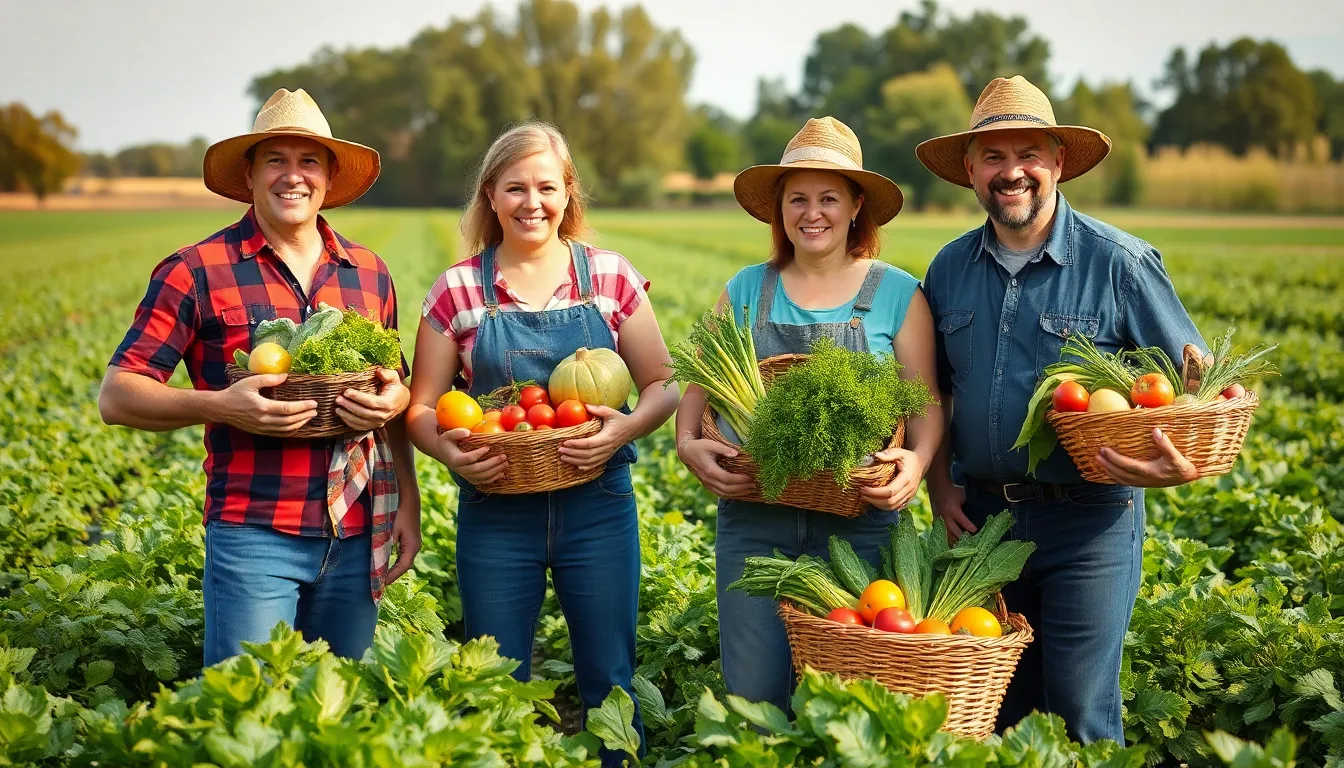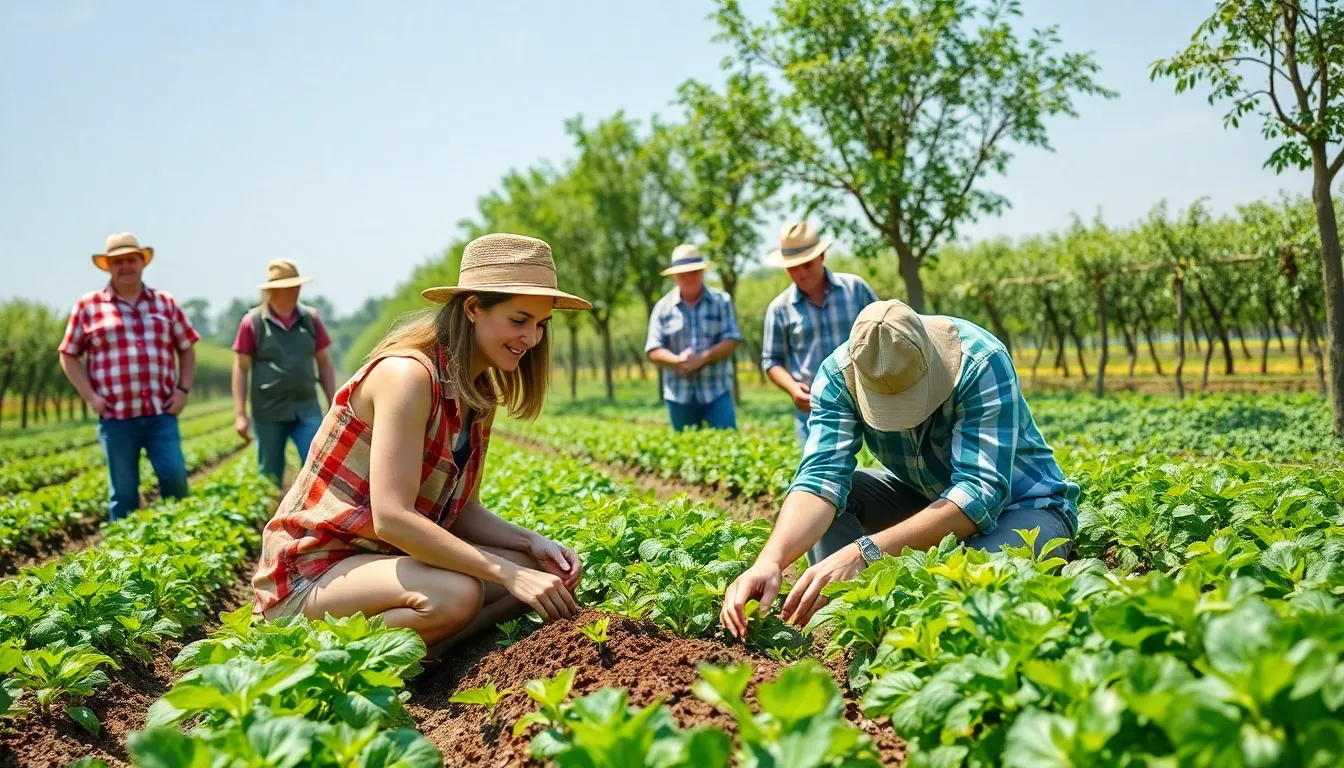Community Supported Agriculture (CSA) is revolutionizing the way people connect with their food. By bridging the gap between local farmers and consumers, CSA programs create a direct relationship that benefits both parties. Members buy shares in a farm’s harvest, receiving fresh, seasonal produce throughout the growing season. This model not only supports local agriculture but also fosters a sense of community among participants.
As more individuals seek sustainable and healthy food options, CSA has gained popularity. It offers a unique opportunity for consumers to know where their food comes from while helping farmers thrive. By investing in local farms, communities can cultivate a deeper appreciation for the land and the effort that goes into producing their meals. Embracing CSA can lead to a more sustainable and connected food system.
Table of Contents
ToggleOverview of Community Supported Agriculture
Community Supported Agriculture (CSA) connects consumers directly with local farms by offering shares in the farm’s seasonal harvest. Members invest in a farm at the beginning of the growing season, receiving a portion of the produce throughout the season. This model supports local farmers financially, allowing them to plan for the harvest cycle and reduce the economic risks associated with farming.
CSA programs typically include a variety of fresh, seasonal produce, which may encompass fruits, vegetables, and herbs. In addition, some farms expand their offerings to include eggs, dairy products, or meat. Members often receive their produce through weekly or bi-weekly deliveries, either at farm locations or designated pick-up sites in the community.
CSA’s rise in popularity corresponds with the growing interest in sustainable agriculture and healthy eating. Consumers benefit from knowing the origins of their food, fostering transparency within the food system. Additionally, CSA programs often encourage members to engage with farming practices, promoting awareness of environmental issues and food production methods.
Consumers interested in joining a CSA can find various programs to suit different needs and preferences. Some farms offer flexible share sizes or customized options allowing members to select specific items. The opportunities for connection with local farmers and the chance to support community agriculture enhance the appeal of CSA participation.
Benefits of Community Supported Agriculture

Community Supported Agriculture (CSA) offers numerous benefits that support both consumers and local farms. This model promotes economic stability, environmental sustainability, and community engagement.
Economic Advantages
Economic advantages of CSA extend to both farmers and consumers. Farmers gain upfront capital from share purchases, allowing them to cover expenses for seeds, equipment, and labor. Consumers often receive fresher produce at competitive prices, reducing costs associated with middlemen. Additionally, local spending bolsters the regional economy, fostering resilience in the agricultural sector. A 2019 study indicated that every dollar spent on local farms generates approximately $1.76 in local economic activity. This circular economy benefit reinforces the value of supporting local agriculture.
Environmental Impact
Environmental impact favors sustainable practices associated with CSA. Farms typically employ organic farming techniques, reducing pesticide usage and promoting soil health. Local sourcing minimizes transportation emissions, directly contributing to lower carbon footprints. Furthermore, CSA promotes biodiversity through crop variety, enhancing ecosystem resilience. Research published by the Organic Farming Research Foundation notes that organic methods can enhance soil quality and water conservation by implementing crop rotation and cover cropping. By connecting consumers with local food systems, CSA cultivates awareness of sustainable practices that benefit the planet.
How Community Supported Agriculture Works
Community Supported Agriculture (CSA) operates through a membership-based system that connects consumers directly with local farms. Members support farmers financially at the beginning of the growing season, enabling a cooperative relationship that benefits both parties.
Membership Structure
Membership typically involves purchasing a share of the farm’s harvest. Members commit to a full season, contributing funds that provide upfront capital for farmers. Share sizes may vary, allowing flexibility; common options include individual and family sizes, accommodating different household needs. Members usually pay a fee ranging from $200 to $600, depending on the farm’s offerings and season length. In return, they receive regular deliveries of fresh produce, fostering a strong bond between farmers and the community.
Distribution Methods
CSA farms utilize various distribution methods to deliver fresh produce to members. Common approaches include:
- On-site Pick-up: Members collect their shares directly from the farm, encouraging interaction with farmers.
- Neighborhood Drop-off Locations: Local sites serve as convenient pick-up spots, making fresh produce accessible to broader communities.
- Home Delivery: Some farms offer home delivery services for added convenience, catering to busy families and individuals.
These distribution methods facilitate consistent access to seasonal produce while strengthening community ties and supporting local economies.
Challenges of Community Supported Agriculture
Community Supported Agriculture (CSA) faces several challenges that can impact its sustainability and effectiveness. Addressing these challenges is essential for growing this model and ensuring long-term viability for both farmers and consumers.
Seasonal Variability
Seasonal variability presents a significant challenge for CSA programs. The availability of crops fluctuates based on growing seasons, weather conditions, and regional climates. Members may experience limited variety in their shares during certain times of the year. For instance, winter months often yield fewer options, leading to potential dissatisfaction among subscribers expecting diverse produce year-round. Moreover, climate change exacerbates unpredictability, resulting in irregular harvests and decreased crop yields, which can threaten farm viability and consumer commitment.
Community Engagement
Community engagement is crucial for the success of CSA but often proves challenging. Effective communication between farmers and members fosters trust and loyalty. However, busy schedules and distance can limit participation in community events and farm visits. Engaging members through educational initiatives about farming practices or cooking demonstrations can enhance understanding and commitment, yet it requires time and resource investment from farmers. Additionally, some consumers may have limited experience with unfamiliar produce, necessitating guidance to maximize their CSA experience. Maintaining consistent engagement through newsletters, social media, and events can help strengthen community ties and promote the CSA model effectively.
Community Supported Agriculture represents a powerful shift in how individuals connect with their food and local farmers. By investing in CSA programs, consumers not only enjoy fresh produce but also contribute to a more sustainable agricultural system. This partnership fosters economic stability and encourages environmentally friendly practices that benefit everyone involved.
While challenges exist, the potential for growth and community engagement remains strong. As more people seek healthy and sustainable food options, CSA programs are likely to continue evolving, enhancing their impact on local economies and environmental awareness. Embracing this model can lead to a more resilient and interconnected food landscape for future generations.




